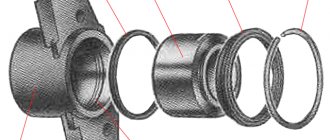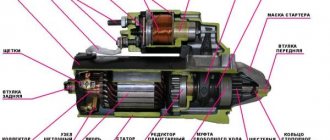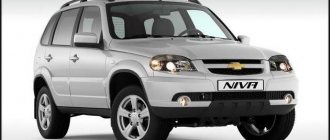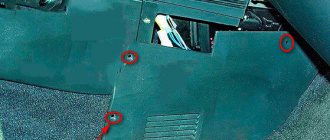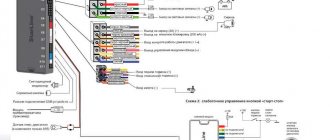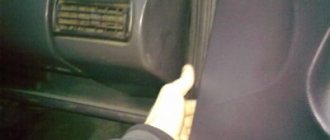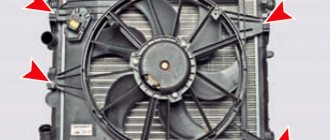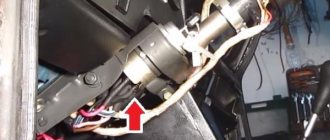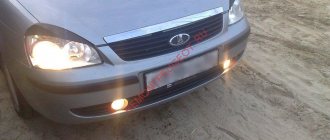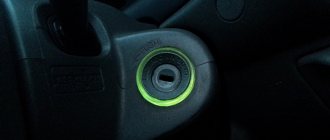Caliper jammed on the road: causes and symptoms
The caliper jams and fails due to overheating, dirt and moisture getting into it. There are also other provoking factors:
- Wear of the brake mechanism. This happens when the driver does not monitor the car parts and does not carry out timely diagnostic maintenance. The caliper becomes unusable and jams, often right on the road.
- Incorrect pad installation. When they are not parallel to the discs or in the wrong places due to an error during the repair, the brake mechanism jams.
- Lack of lubricant or incorrect selection. Typically, drivers try to save on lubrication, which is fraught with many problems. It is necessary to select a product that can reduce friction during the operation of parts and has cooling properties. High-quality lubrication should provide the mechanism with protection from exogenous adverse factors. Especially in winter, when the road is strewn with ice, snow, and stones.
When a caliper jams, it is accompanied by a number of characteristic symptoms:
- the discs become very hot, there is a burning smell in the cabin (these manifestations are typical for overheating of the brake mechanism parts);
- when you press the brake, the car pulls to the side (usually to the one where the jammed caliper is located);
- after releasing the brake pedal, a creaking sound is heard in the cabin - a sign of wear on a part of the brake system;
- brake fluid is heavily consumed;
- There are drops of oil visible on the wheel rim.
If the caliper jams on the road, the car may begin to brake on its own. This happens because the brake pads are in constant contact with the discs. As a result, the car will constantly brake, even when the driver does not touch the brake pedal. The pads will begin to deteriorate faster.
If even one of these phenomena is detected, it is important to take immediate measures - diagnose the brake system and eliminate the identified problems.
Signs of a stuck caliper
- There was a feeling that the car's rolling speed had worsened.
- When stopping at almost zero speed, if you release the brake pedal, the car continues to brake and stops confidently.
- If you stop on a slight slope, the car does not try to roll down it when you release the brake pedal.
- You may feel like the car is being pulled to the side on a flat road.
- After a short trip with active braking, the smell of burnt pads may appear in the cabin; this is more true for the front brakes.
- You may notice increased gas consumption, and finally...
- An exact sign that needs to be checked by leaving the car after driving with active braking. Touch all four wheel discs or calipers in turn; discs with a significantly higher temperature indicate a jammed caliper, namely the guides or the working piston of the caliper.
How to carry out independent repairs if the caliper is stuck on the road
If the driver notices signs indicating that the brake mechanism is jammed, the following is urgently required:
- Stop the car. Turn off the engine.
- Take a small board, attach it to the caliper, and knock lightly.
Of course, there is no 100% guarantee of the effectiveness of this method, but when there is absolutely no time, like other available means, they resort to it.
It is best to carry out self-diagnosis. The algorithm is as follows:
- leave the car cold for at least 15 minutes;
- drive 100 meters to warm up the vehicle;
- stop the car, test each wheel - which one will be the hottest, that’s where the caliper is stuck.
Next, carry out the following actions:
- jack up the vehicle and remove the wheel;
- when the handbrake cable is jammed, clean it with universal lubricant WD-40;
- If the piston is jammed, use the plank method described above.
When the driver does not have the skills to carry out emergency repairs, it is better to call a tow truck to take the car to professional mechanics.
What to do if the brakes, caliper, pads are stuck
- Instructions
- Auto repairs in Moscow
- Showdown Russia
- Used spare parts
- Buy for analysis
- Site Map
- Contacts
Δ You took the car off the handbrake, and the car stopped moving. The parking brake indicator on the instrument panel comes on and does not go out. The car began to drive heavily, as if something was preventing it from rolling normally, there was some kind of grinding noise and the sound of friction was heard.
"All of these symptoms indicate that your car has one of the following problems:
- The hand (parking) brake cable is jammed
- Caliper jammed
- The block is jammed
- Cylinder jammed
"The first thing to do is to determine which wheel is jamming. We start the car and drive 10-15 meters, it will be difficult to drive, but quite possible. Then, using our own finger, we test all four wheels. » Touch the surface of the brake disc with your finger through the holes in the wheel rim.
• If the problem occurs to you on the road, then before performing the test, you need to let the brake discs cool for 20-30 minutes.
• We put the car on a jack, remove the wheel and see what the problem is.
The hand (parking) brake cable is jammed.
Reasons: The braid is frayed inside or outside - this can be solved by replacing the cable. The return spring has weakened - this can be solved by replacing the spring with a new one. The mechanism of two return brackets has become sour and rusty - clean off the rust and spray with WD-40.
• A quick solution on the road is to return the cable to its original position by hitting the return bracket or spring with a hammer. You can check how the pads are wedged by turning the brake disc by hand. It should turn easily, but with a slight tightness. You can continue driving, but before replacing the cable or spring, DO NOT use the handbrake!
The brake caliper is stuck.
Reasons: mechanical particles or corrosion on the walls of the piston and cylinder interfere with the normal stroke of the piston - this can be solved by replacing it with a new unit or rebuilding the caliper using a repair kit.
• A quick solution on the road is to gently tap the caliper with a hammer through a piece of wood, 50/50, which will wedge it. Another option is to carefully try to insert a screwdriver between the pad and the disc, so that the pad moves away a little. It will be very difficult, but 50/50 it might work out.
The brake pad is stuck.
Causes: Destruction and misalignment of the pad. She fell off her seats. The friction material has completely worn out.
• A quick solution on the road is to replace it with a new set (if available), install it correctly, if it is skewed, if the block is broken, remove it and carefully drive to the nearest service center.
Front caliper jammed: reasons
When the driver is used to driving at high speed, a little carelessly, then the front caliper often jams. This type of breakdown is more common in modern vehicles, where this mechanism operates faster in the front part. As a result, a colossal load falls on the caliper.
Most cars have a pressure regulator, which is popularly called a “sorcerer”. If you brake sharply, fluid access to the rear of the car is blocked. The front one continues to function and heat up.
Rear brake jammed: reasons
Typically, the structure of the rear caliper is complicated by the parking brake. The mechanism includes a number of elements:
- coupling;
- spring;
- balloons;
- stock.
When damage occurs in one of them, it affects the operation of the clamping device.
Mechanics quickly identify problems caused by problems with the handbrake. The main symptom is poor performance of the brake mechanism when trying to press on the pedals. There are also indirect manifestations: uneven wear of the linings, creaking, braking of the rear axle.
Preventive actions
To avoid such an unforeseen situation when the caliper jams on the road, you need to take a number of preventive measures:
- Preventative maintenance of the caliper should be carried out when replacing levers. They are changed every 2 years.
- During diagnostics, all parts of the car should be inspected, including the adjustment of the hand brake. It is worth taking your car for inspection once every six months. If any suspicious noise occurs, send it to a service station immediately.
- Due to the large loads to which the clamp is subjected, it is necessary to use lubricants suitable for a particular vehicle. If you save money and buy low-quality compounds, they will quickly harden and deteriorate due to moisture. The lubricant must have minimal dripping characteristics, be moisture resistant, and not susceptible to the influence of chemicals. If you can’t make a choice yourself, the service station technicians will select the appropriate composition themselves. An alternative to expensive lubricant is WD-40. The composition protects automotive parts from corrosive plaque.
With timely care and careful operation of the car, the risk of the caliper getting stuck on the road is minimal. If such a nuisance happens on the road, you need to react quickly and clearly. Remember, if the caliper is jammed, this is fraught with an accident if you cannot cope with the vehicle.
Has your caliper jammed on the road? How did you deal with such a situation? Share your experience with other car enthusiasts.
What to do if the caliper sticks? Answer in video:
To give the calipers an aesthetic appearance, they can be painted. How to do this correctly - read the feature article. Contents of the article
Hi all! Any problems associated with the braking system of vehicles are potentially very dangerous. Therefore, every motorist should know why the brake caliper jams, what can provoke such a situation, how to diagnose and eliminate it. On your own or with the help of specialists, decide for yourself.
Our regular readers remember that we have previously talked about situations when the caliper knocks. Now let's consider a slightly different situation. Moreover, it is even more dangerous and unpredictable in terms of possible consequences if nothing is done after noticing the symptoms.
Let's start with the theory. The caliper on a car is part of the brake system. It is used in the design to press automobile brake pads when the corresponding pedal is pressed against the brake disc. As you understand, the node is extremely important.
But sometimes it can jam and creak because of this.
Other reasons why front brakes stick
The front wheels do not always jam the same way; this can manifest itself in different ways. Both front wheels can “stick” at once, and you simply won’t be able to move. It happens that they seem to be spinning, but with great difficulty, making a creaking sound. This is a dangerous situation, especially if you ignore the problem and continue driving. Only one front wheel can jam, while the other spins freely. Let's look at the possible reasons.
- The brake pedal is poorly adjusted or has no free play at all
.
There must be sufficient clearance between the master cylinder piston and the pusher for the pedal to move normally. This is adjustable.
Brake pad tension spring is faulty
.
This does not mean that it is cracked or completely torn, perhaps just stretched. There is such a thing as metal fatigue, and a weakened spring will no longer function normally; it is better to replace it.
Another reason why the front brakes stick is that the vacuum booster is not in order.
.
It can jam for several reasons. The diaphragm may be swollen, or the protective cap or lid seal may be pinched.
Pay attention to the amplifier adjusting bolt. It shouldn't be too tight. It is important that it protrudes slightly above the surface of the master cylinder.
There is something wrong with the brake pad friction lining.
.
The problems can be different: the gasket wears out, breaks, or becomes too thin. This usually leads to damage to the pad itself, so in this case both it and the lining have to be replaced. Important: if you are changing a worn gasket, then the pair to it should also be replaced; they must be the same in thickness, otherwise the car will be pulled off the line of movement to the side.
The reason that the front brakes are sticking may be a stuck piston in the wheel brake cylinder.
.
This kind of trouble can happen in any car, so you need to be able to deal with it. The reasons for this situation are different: low-quality brake fluid, uneven position of the cylinder body in the caliper, rust and corrosion on the working surfaces of the piston. Disassemble the problematic cylinder, clean all components, rinse with brake fluid, reassemble the system and bleed. Fill with good quality brake fluid.
Features of work
First, let's try to imagine the ideal operation of a caliper as part of a car's braking system.
In fact, this is a mandatory component of any car, be it:
See alsoTrailer for fishing and hunting: where to buy, do-it-yourself modification
- VAZ 2110;
- VAZ 2109;
- Lada Kalina;
- Chevrolet Lanos;
- Lada Priora;
- VAZ 2114;
- Chevrolet Niva;
- Lada Kalina;
- VAZ 2112;
- Daewoo Nexia;
- Volkswagen Polo Sedan;
- Skoda Octavia;
- Mercedes E class, etc.
Regardless of whether it is installed on a Niva or a BMW, the caliper must be in constant working order.
This is the direct task of the car owner himself. Or persons responsible for maintaining the machine and maintaining it in proper technical condition.
Before determining why it does not press out and what to do to prevent the car caliper from jamming, you need to understand the principle of its operation.
In optimal condition, when the brake assembly is working properly, the operating diagram looks like this:
- the driver presses the brake pedal;
- pressure is built up inside the braking system;
- this pressure is transmitted to the piston group of the auto calipers;
- the calipers, being under high pressure, bring the brake pads to the disc;
- the braking disc is attached to the car wheel;
- friction force arises;
- wheel rotation slows down;
- the car stops;
- or reduces the speed to the required values.
As you can see, in theory there is nothing complicated. But in fact, the caliper is rightly called an extremely complex element.
For the brakes to work effectively, it is important to ensure that the pad is parallel to the disc.
Friction during active braking causes heat production. This heats up the pad, brake fluid and our caliper.
Therefore, it is extremely necessary that the car caliper be made on the basis of a material that does not change its properties and characteristics during the process of strong heating. Plus, there are increased requirements for strength.
Working principle of brake caliper
The operation of the caliper is based on the following principle:
- When you press the brake pedal, pressure builds up inside the brake line;
- The resulting pressure is subsequently transmitted to the piston group of all calipers;
- Under the influence of caliper pressure, the brake pads begin to move towards the disc on the rotating wheel;
- A friction force arises, which leads to deceleration.
Since friction necessarily occurs in the braking process, heat is generated in the mechanism. For normal operation of the caliper, the device must be made of a material that is not capable of changing under the influence of heat. The material of the calipers must also be strong and able to withstand the loads placed on it.
Causes of jamming and creaking
Now directly about how to determine the presence of a problem.
The primary sign indicating a malfunction in the calipers of a car brake system is squeaking.
See also: Lift kit for Niva: which one to buy and how to install it yourself
It is the creaking that indicates that the element is seriously worn out. In the near future, the unit must be replaced without fail, which the car literally and figuratively screams about. It is extremely difficult not to hear such a creak. But for some reason, thousands of motorists still stubbornly ignore it. As a result, they pay a rather high price. Sometimes even to the point of road accidents resulting from brake failure while driving. To prevent this, you need to understand the issue and understand the essence of what is happening.
The first step is to look at the possible causes. In fact, there are several potential problems to look for. Some of them arise due to the fault of the motorist, others are caused by the natural process of wear and tear.
In any case, the appearance of a squeak as a symptom is a harbinger that at the most inopportune moment the caliper may simply jam.
If you know the reasons, you can prevent them and troubleshoot them by contacting a car service center or solving the problem yourself.
The reasons are:
- The brake pads were initially installed incorrectly. As a result, they are not strictly parallel to the response drives. Because of this, creaking often appears;
- The brake discs are seriously worn out. The reasons are natural wear and tear and aggressive use of the car;
- There is no lubrication in the unit. Initially there was little of it, or it was used up;
- The lubricant was selected incorrectly. Many people skimp on lubricant intended for calipers, hence the consequences.
The most undesirable and dangerous situation is rightly considered when the piston does not return and the unit begins to jam during operation.
Imagine that you are driving a car, press the brake, and then accelerate again. But at the same time, the calipers do not release the front brakes. Additional resistance arises, the car tries to move, but cannot. The result is uncontrolled braking, extremely intense wear and serious overheating of the entire system.
What to do in such a situation
If you were able to diagnose creaking and signs of wedging in this unit, you need to perform a number of measures.
And here it is not necessary to contact a car service. You need:
- put the car on a jack;
- remove the wheel;
- unscrew the caliper;
- remove it;
- unscrew the problematic piston;
- remove the piston from the cylinder;
- visually inspect the element;
- check for chips, damage, corrosion;
- if there is rust, clean it;
- if severely damaged, replace;
- drain the working fluid from the element;
- remove the sealing ring;
- clean all surfaces;
- dry;
- fill in new hydraulics;
- assemble in reverse order.
When putting the assembly back together, pay special attention to not accidentally damage the old boot. If you notice cracks on it, then no restoration will help. Replacement only.
What to do if the caliper creaks or jams
If the brake caliper creaks or jams, and the part is in good condition, you can try to fix the problems yourself. To do this, it is recommended to perform the following set of actions:
- The first step is to unscrew the brake caliper; to do this, you need to put the car on a jack and remove the wheel. It is worth noting that in some car models the caliper can be unscrewed counterclockwise;
- Having removed the caliper, unscrew the piston using a wrench, then it must be pulled out of the cylinder;
- The removed parts must be carefully inspected for chips, rust, corrosion and various damages. If rust is found, it needs to be cleaned well. When the calipers are heavily worn, problems may arise with cleaning the rust with improvised means; in such a situation, the part will need to be sanded;
- After cleaning the caliper from rust, drain the liquid from it, remove the sealing ring and clean everything thoroughly, special attention should be paid to the place where the ring is attached;
- Next, all the parts need to be dried, filled with liquid, and the caliper put back together.
Important: When reassembling the caliper, pay special attention to the boot so as not to accidentally damage it. If there are cracks on the boot, be sure to replace it.
Prevention measures
See alsoTrailer with a plastic cover: which one to buy, review of models
I can say from personal experience that the detailed cleaning procedure is quite complicated. This will definitely take more than one hour.
To minimize the number of repetitions of such operations, be sure to lubricate the caliper twice a year for preventive purposes. It is optimal to use professional special lubricants designed specifically for this element. But regular WD40 is also an alternative. It will definitely protect against corrosion.
Plus, visually inspect the condition once a year. Make sure that the assembly is free of damage, dirt and signs of corrosion. Make sure that the boot does not rupture during operation. Otherwise, the caliper will not last long after this.
You need to monitor all brake systems, including periodic adjustment of the handbrake. After all, this is also an integral part of vehicle safety.
That's all for me. If you have any questions, ask them in the comments. We will try to answer quickly.
Subscribe, leave reviews, tell your friends about our project!
In heavy traffic conditions, a malfunction of the brake system is especially dangerous. The caliper is designed to press the pads against the brake disc. If it jams, the car will not only lose braking efficiency, but will also have difficulty moving.
If symptoms of failure of this element appear, immediate action must be taken.
Symptoms of a stuck caliper
One of the main reasons for this phenomenon can be considered overheating. This is facilitated by initially incorrect installation of the brake pads, lack of adequate lubrication, and water and dirt getting inside the mechanism.
Severe disc wear also increases the risk of jamming, so the best manufacturers try to use the most durable materials for their products.
The initial stages of jamming can be determined by the following signs:
- strong heating of the discs, which is accompanied by a pronounced burning smell for no apparent reason;
- the car pulls to the side after pressing the brake pedal;
- strong grinding noise after releasing the brake pedal;
- decrease in brake fluid level inside the expansion tank;
- the appearance of oily spots on the inside of the wheel rim.
If one or more of the described symptoms occurs, certain measures must be taken immediately to correct the situation.
Causes of squeaking and jamming of the caliper
The initial warning signal to a motorist about the presence of a malfunction in the operation of a car caliper should be the appearance of a creaking sound. This factor may indicate severe wear of the car caliper. In addition, the following problems may be among the main causes of squeaking:
- Incorrectly installed brake pads;
- Lack of lubricant or incorrectly selected lubricant;
- Excessive wear of brake discs.
If the pads are not parallel to the brake discs, this will most likely lead to squeaking. In addition, an unpleasant sound may appear due to an incorrectly selected lubricant. The lubricant must meet the requirements.
What to do if a problem occurs?
If the motorist is confident that the caliper is in good condition, and creaking and jamming occur, then you can try to solve the problem yourself. You can do this as follows:
- Unscrew the brake caliper;
- Then unscrew the piston with a wrench and pull it out of the cylinder;
- Inspect the dismantled part for chips and cracks, rust and other damage;
- If necessary, clean the part from rust using improvised means;
- Drain the fluid from the caliper and remove the sealing ring;
- Dry all the parts, pour the liquid back in and reassemble the part.
Since the procedures described above require a lot of time from the performer, preventive measures may be the best way out of the situation. To avoid the formation of corrosion, once every six months, car calipers must be lubricated with a special lubricant and the part must be periodically visually inspected for damage.
This video will talk about caliper squeaking and how to eliminate it:
